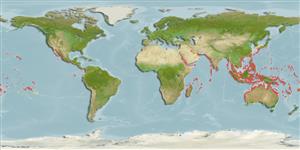Bivalvia |
Lucinida |
Lucinidae
Environment: milieu / climate zone / depth range / distribution range
Ecology
Benthic; depth range 0 - 20 m (Ref. 348). Tropical
Indo-Pacific: from East and South Africa, including Madagascar and the Red Sea, to eastern Polynesia and Hawaii and from southern Australia to northern Japan.
Length at first maturity / Size / Weight / Age
Maturity: Lm ? range ? - ? cm Max length : 9.0 cm SHL male/unsexed; (Ref. 74338); common length : 5.0 cm SHL male/unsexed; (Ref. 348); max. published weight: 210.00 g (Ref. 74338)
Often buried just under the surface of the sandy-muddy substrates near mangrove areas (Ref. 80041). Occurs in mudflats. Abundant shells are present among shell debris in shallow tidal channels within lagoons (Ref. 101158). Deposit-feeder (Ref. 348). Suspension feeder (Ref. 108437).
Life cycle and mating behavior
Maturity | Reproduction | Spawning | Eggs | Fecundity | Larvae
Members of the class Bivalvia are mostly gonochoric, some are protandric hermaphrodites. Life cycle: Embryos develop into free-swimming trocophore larvae, succeeded by the bivalve veliger, resembling a miniature clam.
Poutiers, J.M. 1998. (Ref. 348)
IUCN Red List Status (Ref. 130435)
CITES status (Ref. 108899)
Not Evaluated
Not Evaluated
Threat to humans
Human uses
Fisheries: commercial
| FishSource |
Tools
More information
Age/Size
Growth
Length-weight
Length-length
Morphology
Larvae
Abundance
Internet sources
Estimates based on models
Preferred temperature
(Ref.
115969): 24.1 - 29.3, mean 28.3 (based on 3924 cells).
Vulnerability
Low vulnerability (10 of 100).
Price category
Unknown.
